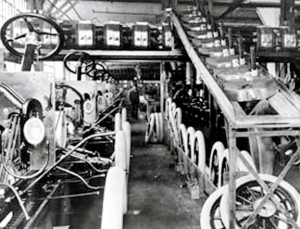
There are sound economic reasons why all industrialized nations, except the U.S., protect their auto industry.
The U.S. auto industry provides a substantial contribution to U.S. economic health, according to the latest study released this morning by the Sustainable Transportation and Communities group at the Center for Automotive Research (CAR).
The non-profit research organization looked at the economic and employment impact of automakers, parts suppliers, and dealerships in contributing to the economies of all 50 states.
The automotive industry spends $16 to $18 billion dollars a year on research and product development, half a trillion dollars on employee compensation, and is the major leader of the overall manufacturing contribution to the gross domestic product.
“It is difficult to imagine manufacturing surviving in this country without the automotive Sector, said Kim Hill, director of the Sustainable Transportation and Communities group at CAR, and the study’s lead.
“The industry’s impact is huge on a host of other sectors as diverse as raw materials, construction, machinery, legal, computers and semiconductors, financial, advertising, health care and education. In this time of national introspection concerning the value of the U.S.-based auto industry, it is clear the value is quite high,†Hill said.
The study was written by Hill, Deb Menk, project manager, and Adam Cooper, research associate. The complete study is available at www.cargroup.org.
“The CAR study results provide strong evidence of the deep vertical and horizontal integration of the U.S. auto industry with so much of the U.S. economy,†said Sean McAlinden, executive vice president of research and chief economist at CAR.
“The study also illustrates the high productivity potential of the U.S. auto industry and the importance of its role in leading the U.S. economy in the current recovery. This study definitely proves that federal assistance to the industry last year will produce many benefits in jobs, income, and public revenues for years to come,†said McAlinden.
For the study, the authors assumed:
- Vehicle manufacturers (OEM) directly employed 313,000 people
- Includes manufacturing, research and development, headquarters, and all other operational activities
- 686,000 people were employed in the automotive parts sector
- Includes a percentage employment from rubber, plastics, batteries, and other non-automotive sectors
- 737,000 people were employed in the dealer network selling and servicing new vehicles
- 1,736,000 people were employed in the entire industry
- The study shows that these 1.7 million direct jobs contribute to an estimated
- 8 million total private sector jobs
- More than $500 billion in annual compensation and
- More than $70 billion in personal tax revenues
Therefore, the employment multiplier for OEM activities is 10, while the employment multiplier for the entire industry is 4.
The Center for Automotive Research’s mission is to “conduct research on significant issues related to the future direction of the global automotive industry, as well as organize and conduct forums of value to the automotive community. CAR performs numerous studies for federal, state and local governments, corporations, and foundations. The Sustainable Transportation and Communities group focuses its research on the long-term viability and sustainability of the auto industry, the surface transportation system, and the communities that lie at the heart of both the industry and the system.”
